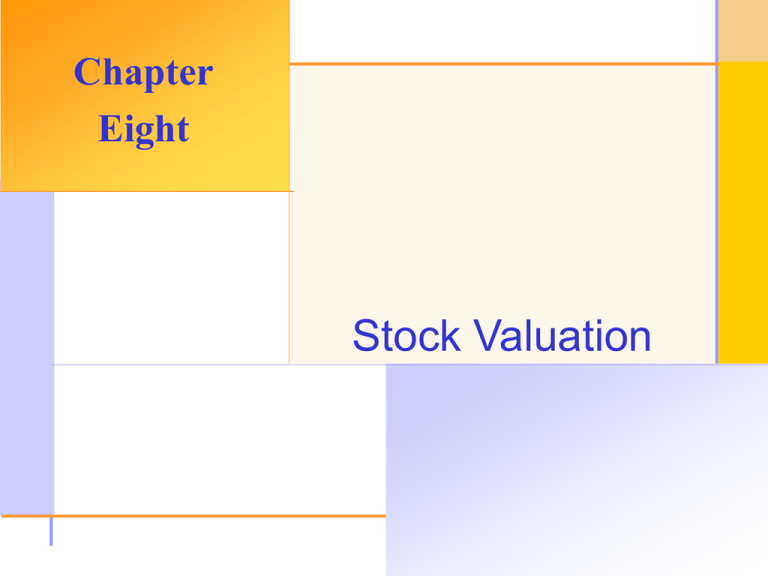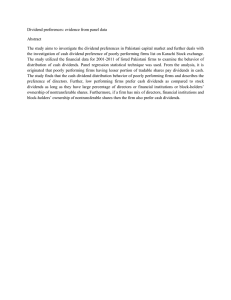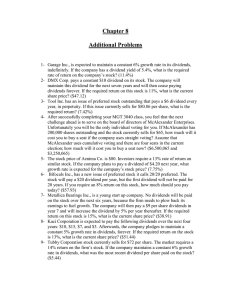
Chapter
Eight
Stock Valuation
© 2003 The McGraw-Hill Companies, Inc. All rights reserved.
8.1
Chapter Outline
Common Stock Valuation
Common Stock Features
Preferred Stock Features
Stock Market Reporting
8.2
Cash Flows for Shareholders 8.1
If you buy a share of stock, you can receive
cash in two ways
Dividends
Selling your shares
As with any asset, the market price of
common stock is equal to the present value of
the expected future cash flows the stock will
generate
8.3
One Period Example
Suppose you are thinking of purchasing the stock of
Moore Oil, Inc. and you expect it to pay a $2 dividend
in one year and you believe that you can sell the stock
for $14 at that time. If you require a return of 20% on
investments of this risk, what is the maximum you
would be willing to pay?
Compute the PV of the expected cash flows
Div 1 Sale Price
PVStock
1 r
Calculator Approach
FV
PMT
N
I
PV
$
8.4
Two Period Example
Now what if you decide to hold the stock for two
years? In addition to the $2 dividend in one year,
you expect a dividend of $2.10 in two years and a
stock price of $14.70 at the end of year 2. Now
how much would you be willing to pay now?
Div 1 Div 2 Sale Price
PVStock
2
1 r
1 r
Calculator Approach
CFj
CFj
CFj
I
2nd NPV
$
8.5
Three Period Example
Finally, what if you decide to hold the stock for
three periods? In addition to the dividends at the
end of years 1 and 2, you expect to receive a
dividend of $2.205 at the end of year 3 and a stock
price of $15.435. Now how much would you be
willing to pay?
Div 1
Div 2 Div 3 Sale Pr ice
PVStock
2
1 r 1 r
1 r 3
Calculator Approach
CFj
CFj
CFj
CFj
I
2nd NPV
$
8.6
Developing The Model
We could continue this process for many time
periods
In fact, the price of the stock is just the present
value of all expected future dividends
So, how can we estimate all future dividend
payments?
8.7
Estimating Dividends: Special Cases
Constant dividend
The firm will pay a constant dividend forever
Market instrument – preferred stock
Price is computed using the perpetuity formula [PV = C/r]
Constant dividend growth
The firm will increase the dividend by a constant percent every
period
Market instrument – common stock
Price is computed using a growing perpetuity formula
[PV = C/(r-g)]
Supernormal growth
Dividend growth is high initially, but later settles down to a
long-run constant growth rate
8.8
Zero Growth Rate
The dividends on most preferred stocks are
expressed as a constant percentage of the share’s
face value
Suppose a preferred share is expected to pay a
$0.50 dividend every quarter and the required
return is 10% with quarterly compounding.
What is the price?
PVPreferred
Stock
Div 1
r
8.9
Constant Growth Rate
To value a common stock, we usually assume the dividend
stream will grow at some constant growth rate over time
P0
Div 3
Div 1
Div 2
Div
.
.
.
1 r 1 r 2 1 r 3
1 r
Div 0 1 g Div 0 1 g
Div 0 1 g
Div 0 1 g
.
.
.
1 r
1 r 2
1 r 3
1 r
2
With a little algebra, this reduces to:
Div 0 (1 g) Div 1
P0
r -g
r -g
3
8.10
Constant Growth: Example 1
Suppose Big D, Inc. just paid a dividend of
$0.50. It is expected to increase its dividend
by 2% per year. If the market requires a
return of 15% on assets of this risk, how
much should the stock be selling for?
Div 0 (1 g)
P0
r -g
8.11
Constant Growth: Example 2
Suppose TB Pirates, Inc. is expected to pay a
$2 dividend in one year. If the dividend is
expected to grow at 5% per year and the
required return is 20%, what is the price?
Div 1
P0
r -g
Stock Price Sensitivity to Dividend Growth, g
250
Div1 = $2; r = 20%
200
Stock Price
8.12
150
100
50
0
0
0.05
0.1
Growth Rate
0.15
0.2
Stock Price Sensitivity to Required Return, r
250
Div1 = $2; g = 5%
200
Stock Price
8.13
150
100
50
0
0
0.05
0.1
0.15
Required Return
0.2
0.25
0.3
8.14
Gordon Growth Company – Example 1
Gordon Growth Company is expected to pay
a dividend of $4 next period and dividends
are expected to grow at 6% per year. The
required return is 16%.
What is the current price?
Div 1
P0
r -g
8.15
Gordon Growth Company – Example 2
What is the price expected to be in year 4?
Div 5
P4
r -g
Div 1 1 g
r -g
4
8.16
Gordon Growth Company - Continued
What is the holding
period return
(capital gains yield)
due to the capital
gain over the four
year period?
P4 P0
HPR
P0
8.17
Non-constant Dividend Growth
Suppose a firm is expected to increase dividends by 20% in
one year and by 15% in year 2. After that, dividends will
increase at a rate of 5% per year indefinitely. If the last
dividend that was just paid was $1 and the required return is
20%, what is the price of the stock?
Remember that we have to find the PV of all expected future
dividends.
0
$1.00
20% 1
15%
2
5%
3
5%
4 5%
∞
8.18
Non-constant Dividend Growth - Continued
Compute the dividends until growth levels off
0
20% 1
$1.00
$1.20
15%
2
5%
$1.38
3
5%
$1.45
Find the present value of the expected future cash flows
P0
Div 1
Div 2 Div 3 1
2
2
1 r 1 r r g 1 r
4 5%
∞
8.19
Calculating the Required Rate of Return
Start with the constant dividend growth formula:
Div 0(1 g)
r-g
Div 1
r-g
rearrange and solve for r
Div 0(1 g)
r
g
P0
P0
Div 1
g
P0
The required rate of return on a common stock can always be
decomposed into:
Dividend yield
Capital gain or loss
8.20
Example – Finding the Required Return
Suppose a firm’s stock is selling for $10.50. They just paid a
$1 dividend and dividends are expected to grow at 5% per
year. What is the required return?
r
Div 0(1 g)
g
P0
What is the dividend yield?
Div 0(1 g)
Dividend Yield
P0
What is the capital gains
yield?
Capital Gain g
8.21
Table 8.1 - Summary of Stock Valuation
8.22
Common Stock – Features
Voting Rights
1- Cumulative voting- total number of votes each shareholder
may cast =
(# of shares owned) x (# of directors to be elected)
All directors are elected at the same time. Cumulative voting
favors minority stockholders.
2- Straight voting- directors are elected one at a time (i.e.,
each director is voted on one at a time). Straight voting favors
majority shareholders.
Staggered elections- only a portion of the board is elected in any
one year. This makes it difficult for minority shareholder to
elect a specific director.
8.23
Example- Voting Rights
A company has two shareholders: “A” (owns 50 shares);
“B” (owns 249 shares). There are 5 directors to be elected
and 7 candidates running (T, U, V, W, X, Y, Z). “A” wants
candidate Z to be on the board. B wants candidates T, U,
V, W, and Y.
Using Straight voting- “A” has 50 votes and “B” has 249
votes. Since each director is voted on one at a time “B”
will be able to vote in all his candidates and “A” will not
be able to vote in his candidate.
Using Cumulative voting“A” has 50 x 5 = 250 votes (all for Z)
“B” has 249 x 5 = 1,245 votes (÷ 5 = 249 for each of T,
U, V, W, and Y)
8.24
Common Stock – Features (cont.)
Other Rights
Share proportionally in declared dividends
Share proportionally in remaining assets during
liquidation
Right to vote on major issues – e.g. mergers
Preemptive right – the right to purchase new stock to
maintain proportional ownership, if desired (i.e., the
right to buy new shares proportionately)
Example
If an investor has 1% of ownership and 1 million new shares
are issued. The investor will have first rights to buy 10,000
of the new shares.
8.25
Common Stock – Features (cont.)
Classes of stock- one has voting power, one
has high dividends
Dual class shares
Voting & not-voting (restricted)
Allows founders to retain control while raising new
equity
e.g. Class A: 1 vote per share, 100% of dividends
Class B: 10 votes per share, zero dividends
(usually not publicly traded)
8.26
Dividends
Dividend size is determined by the board of directors
Dividends are not a liability of the firm until a dividend
has been declared by the board
Consequently, a firm cannot go bankrupt for not
declaring dividends
Dividends and Taxes
Dividend payments are not considered a business expense
and are not tax deductible
Dividends received by individual shareholders are partially
sheltered by the Federal dividend tax credit (13⅓ %)
Dividends received by corporate shareholders are not
taxed, thus preventing the double taxation of dividends
8.27
Preferred Stock Valuation
Preferred stock is a hybrid security with
features of bonds and common stock.
Its bond features is that preferred stockholders
have preference over common stockholders
and have no voting rights.
Its common stock features is that dividends on
preferred stock do not have to be paid (i.e.,
dividends go into arrears and don’t have to be
paid on time).
8.28
Preferred Stock - Characteristics
Preferred stock has priority over common stock upon
liquidation
Dividends
Most preferred stock has a stated dividend that must be
paid before common dividends can be paid
Dividends are not a liability of the firm and preferred
dividends can be deferred indefinitely
Most preferred dividends are cumulative – any missed
dividends on preferred stock have to be paid before a
dividend can be paid on common stock
Preferred stock generally does not carry voting rights








